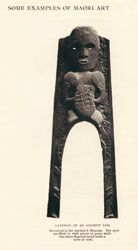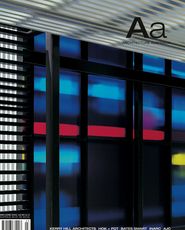
AA 1904–2004 In the early decades of last century the magazines that would become Architecture Australia brought a wide range of material on fine art, decorative art and the architecture of many places to Australian readers. Art and Architecture vol 2 no 1 (Jan-Feb 1905) included the eleven-page article “Some Examples of Maori Art” by Sydney F. Hoben. This was flanked by Samuel Brooks’s “Art Methods in Many Lands” and by “Sydney Domestic Architecture: The Northern Suburbs”.
FESTIVAL-GOERS overflowed the foyer of the Art Gallery of South Australia on a very hot day in early March.
Queues snaked to and fro as a large audience lined up, mostly patiently, to attend the free Architecture Symposium. But the relatively intimate theatre could accommodate only a fraction of the crowd. Some of the rest was housed in an overflow space with a video link-up. But still more didn’t fit. Yet few were dissuaded – by the mid-afternoon sessions the crowd still seemed as big as it had been first thing in the morning, and the occasional temper was starting to fray. The audience included architects and architecture students, but the majority seemed to be festival habitués adding architecture to their programme for the week.
While causing headaches for the organizers, this turnout was gratifying. Architecture, it seemed, had a large and very interested general audience. This might be partly an effect of the contemporary fascination with design as lifestyle accoutrement, but there was also an expectation – voiced in the Minister for Environment and Heritage’s opening speech and in various questions from the audience – that architects might yet save the world.
In his talk that afternoon, Timothy Hill promptly put paid to the suggestion that architects could “lead the debate” with his pithy, amusing, but deadly serious description of the marginal role of architects in contemporary society, the adversarial nature of processes of commissioning, approval and building, and the sheer difficulty of getting anything done in such a context. Architects, he argued, can only do so much – it is up to the public, to the audience as a collective body, to apply pressure, to change processes, to demand better.
This gulf, between expectations of architect-as-style-guru and architect-as-social-redeemer, seems to sum up one conundrum facing the profession. (As does the distance between either of these models and the realities in which most architects find themselves.) Nonetheless, the level of public interest demonstrated at the symposium seems hopeful.
The crowd reminded me of another event, late last year, that was also to be a public forum about architecture, this time one that aimed to bring practitioners and academics together on a rainy Sydney evening.
Convened by Gevork Hartoonian, a panel was asked to consider the state of contemporary architecture in Australia and New Zealand – a big topic, but the panel had an array of impressive critics, historians and theorists from both countries. But the diverse audience was missing and therefore the event lacked dynamism. Gevork had made an effort to invite Sydney’s architectural community, but few practitioners turned up. Instead this smaller crowd comprised the delegates of the annual conference of the Society of Architectural Historians, Australia and New Zealand, of which this panel was the closing event. A thoughtful audience, but one that had already spent the previous three days talking together.
The event would have been livelier and more effective had it become a conversation between practice and academia, in the way Gevork envisioned. Was it the rather dull-sounding name of the society that kept the architects away? That would be a false impression. Every year the SAHANZ conference throws up some fascinating papers, demonstrating that there is very fine work going on in this country’s universities, work that might help us understand more about the contemporary situation, even if tangentially. And some of the best work is by writers who are also well-respected reviewers in this magazine, writers who are well able to communicate with the architectural profession. But little of this scholarly work makes it into the wider architectural world. So what is the audience for this material? Does one exist beyond the confines of academia?
Should one be cultivated, and how might such an audience be reached? What effect might this work have on contemporary practice?
The public, it seems, is interested in architecture, for the moment at least. But different sections of the architectural community might also provide audiences for each other, and in doing so might also engage the public further. Architecture Australia is one place where these different groups do come together, usually on the terms of the profession – academics reviewing buildings – and this is appropriate for the magazine of the RAIA.
But the contrast between those two different crowds made me wonder what else is possible.
JUSTINE CLARK















